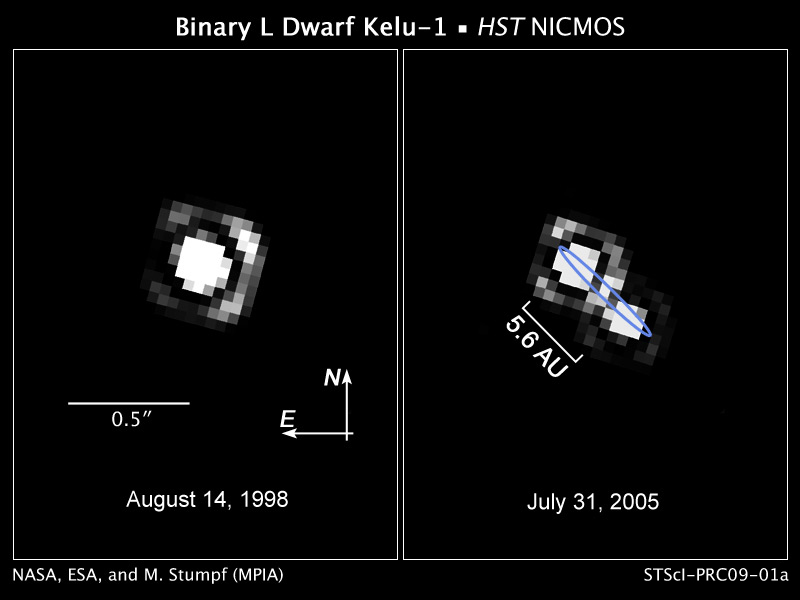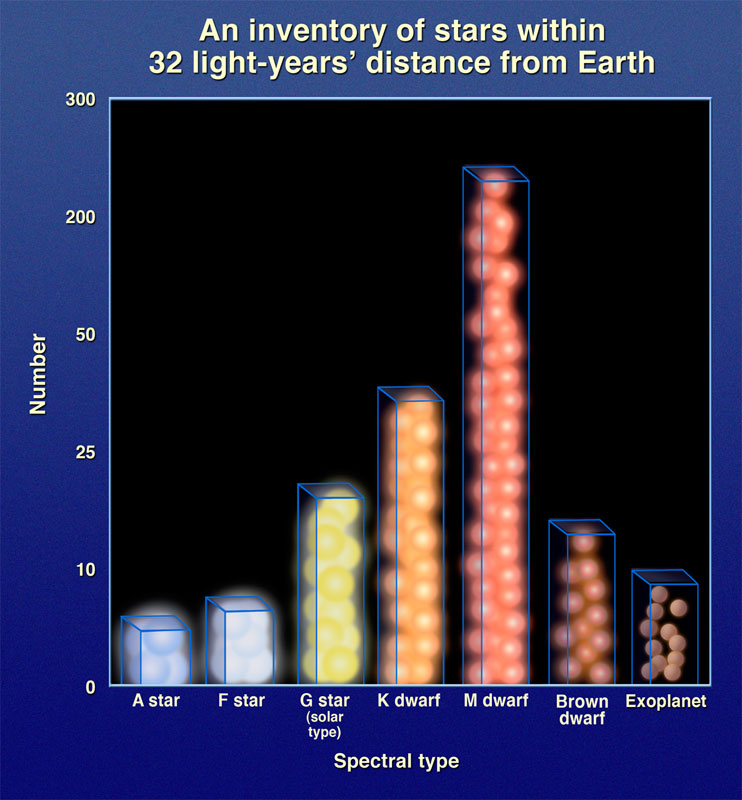Brown dwarfs, objects that are less massive than stars but larger than planets, just got more elusive, based on a study of 233 nearby multiple-star systems by NASA's Hubble Space Telescope. Hubble found only two brown dwarfs as companions to normal stars. This means the so-called "brown dwarf desert" (the absence of brown dwarfs around solar-type stars) extends to the smallest stars in the universe.
The 233 stars surveyed are part of the RECONS (Research Consortium on Nearby Stars) survey meant to understand the nature of the sun's nearest stellar neighbors, both individually and as a population. The current primary goals are to discover and characterize "missing" members of the sample of stars within 32.6 light-years (10 parsecs) of Earth.
RECONS searches for nearby stars through analyzing existing all-sky surveys, combined with observations by a variety of telescopes in both hemispheres. A total of 12 brown dwarfs are currently known within 32.6 light-years of Earth, as compared to 239 red dwarf stars (stars that are largely 20 percent the mass of our sun and are roughly half its diameter and temperature).

In fact, the number of known brown dwarfs is close to that of known extrasolar planets. However, the number of exoplanets known in this region so far is very likely only a lower limit as smaller mass exoplanets are not within our capability of detection at present.
Sergio Dieterich of Georgia State University in Atlanta and team leader of the study is reporting the results today at the 213th meeting of the American Astronomical Society (AAS) in Long Beach, Calif.
"We still did not find brown dwarfs around small red stars whose mass is only slightly above the hydrogen burning limit. Especially when we consider the fact that brown dwarfs binaries do exist, the fact that there are very few binaries whose components lie on different sides of the hydrogen burning limit is significant," says Dieterich.
The Hubble survey, taken with Hubble's Near Infrared Camera and Multi-Object
Spectrometer (NICMOS), provides strong statistics pointing to the fact that brown dwarfs do not exist around even the least massive stars. "If mass ratio was the driving factor we would expect to find more brown dwarfs around small red stars than around solar type stars," says Dieterich.
These results are complementary to another study also being reported at the AAS meeting by Micaela Stumpf of the Max Planck Institute for Astronomy in Heidelberg, Germany. The results imply that brown dwarfs tend to hang out with their own kind.

Graphic of number of stars versus spectral type within 32 light years of Earth. This diagram shows the various stellar populations within 32 light-years of Earth as measured by the RECONS survey. The largest population consists of red dwarfs, but the population of slightly lower mass brown dwarfs drops off precipitously. This is known as the "brown dwarf desert." Credit: NASA, ESA, and A. Field (STScI) Science Credit: NASA, ESA, and T. Henry (Georgia State University)
Nearly ten years' worth of NICMOS observations, combined with recent ground-based adaptive optics results, have provided a first estimate of the orbit of the double brown dwarf system Kelu-1 AB. The eccentric orbit is tilted nearly edge-on to Earth and the dwarfs complete an orbit every 38 years.
Based on the orbital dynamics, the total mass of the system is estimated to be 184 Jupiter masses. But, based on spectroscopic and photometric measurements, the two brown dwarfs are no larger than 61 and 50 Jupiter masses, respectively (a star is no smaller than 75 Jupiter masses). Stumpf is reporting that there may in fact be a third member of the system to account for the "missing mass." This would make it potentially the first ever confirmed triple brown dwarf system.
All-sky surveys planned for the next decade, with advanced telescopes like the Large Synoptic Survey Telescope, promise to ultimately solve the puzzle of the "brown dwarf desert" by doing deep infrared searches for the underlying brown dwarf population.


